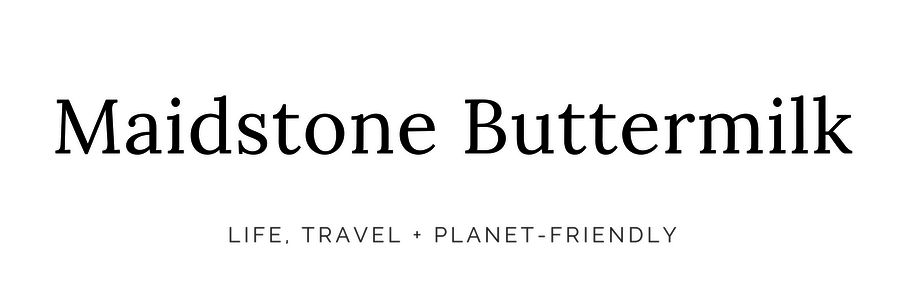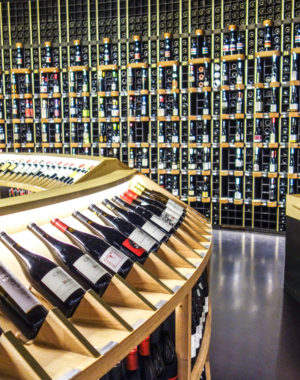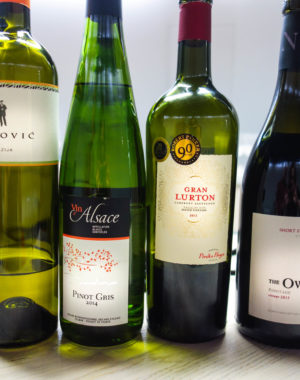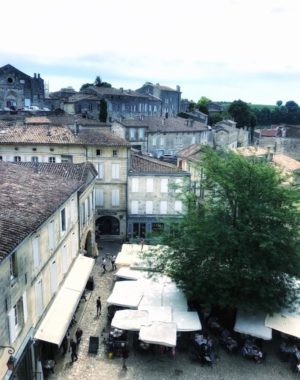Bordeaux may bring to mind rolling vineyards speckled with chateaus and streams that flow from the Atlantic Coast. This isn’t an untruth, but the city of Bordeaux is, in fact, a port city set on the Garonne famed for its fermented exports sourced from the region. A growing metropolis, Bordeaux is the site of start-ups, a new wave of entrepreneurial and community spirit, and several establishments to delve into Bordelais wines, often with a side of Basque tapas or the fixings of a French apéro. Here, even museums are dedicated to the matter.
Museums & Wine Tasting
La Cité du Vin

At La Cité du Vin ticket teller I discovered my arrival was perfectly timed to take A Glass of Wine in Markets of the World class. I jumped at the opportunity and while the price of the museum and class is hefty—some 40 euros with the combined discount—it was well worth it in the museum’s impressive curation and in my four glasses of wine. The class itself is held in a large dome where the teacher is at the center and each of the participants takes a seat and table reminiscent of a trendy Air France lounge. The tour begins with a simulation of a market experience— the lights dim and the walls become screens beaming imagery from an undisclosed area but showcasing its vegetation and landscape all to the hum of recorded sounds to bring you to the area. Essential oils highlighting key herbs to said undisclosed landscape was infused through the room—all of which left us to guess both the locale and essential infusions in the wine. This was quite fun, but I haven’t got a strong sense of smell so all the aromas were lost on me.
Our tour began in Istria, Croatia drinking a malvoisie — a bright white wine meant to pair with Mediterranean cuisine. The next glass was a pinot gris from France’s Alsace. A medium sweet wine, our wine guide recommended this paired with Asian cuisine. The sensory demonstrations helped us learn the elements that were flavoring our wine, but in fact, the food pairing was a surprise and a great tool to elevate not simply what’s in your glass, but the entire meal. Third, we sipped a cabernet sauvignon from Argentina. Wine grown in Argentina’s dry and high mountains tend to be lighter and our guide explained that for this reason, an Argentine cab sauv is ready to drink, whereas a French cab sauv maybe need another 10-15 years to age in the bottle. Even it’s flavor will be drier whereas the French wine will be sweeter. This Argentine cab sauv was recommended to pair with asados or barbecue. The final stop on our tour was a Stellenbosch South African wine made with the area’s signature Pinotage grape. A perfect conclusion, this pairs well with a strong cheese or dessert taken at the end of your meal.
The museum’s permanent installation has to be the most in-depth and interactive way to experience wine without the bottle itself in the world. Each visitor is given a device to experience all of the features of this museum in their language. From videos of wine growers from around the world; the history of types of wine and grapes; the history of Bordeaux-Chartrons as an epicenter of wine trade; entire tables of elements to sniff: from herbs to coffee and beyond; artistic explorations into the feeling of drunkenness; and so much more that I really just need to go back. If you’re passing through Bordeaux, give yourself at least a couple of hours, but do not miss this museum.
Visit La Cité du Vin.
Musée du Vin et du Négoce

The Musée du Vin et du Négoce or Museum of Wine and Trade is set in an old wine cellar below ground and tells the history of how the Bordeaux wine region came to be what it is today. It is fittingly set the area of Bordeaux called Chartrons—at one time a separate city and the true origin of Bordeaux’s own port for wine trading. The museum runs through some of the strict appellation rules and structures for what constitutes a wine from a certain region — learn more about that here. Moreover, we learned about the history of Bordeaux’s wine industry, largely influenced by Dutch merchants who encouraged diversity in blends and flavor profiles to sell to a wider range of palettes around Europe. The task of shipping and storing wine was perfected with the invention of the glass wine bottle by English diplomat, Sir Kenelm Digby.
Perhaps the greatest education to be had at this museum was during the wine tasting following the visit — and included with your ticket. A young and enthusiastic Bordelais man shared in great detail information about the blends, the regions, and rules, avidly using the large map behind him whilst occasionally reminding us, as so many French men seem to, “Me, I am French.”
He explained “second mouth” — when tasting a wine you should spin, sniff, sip, spin, sniff, sip. It’s important to give the wine a second chance to taste it as in your first go, your palette nor your nose is not ready and needs to adjust.
With a glass of red wine, place two fingers side-by-side and peer through the wine-filled glass. If you can’t or can barely see the line that separates your fingers, it is an indication of a good wine whose initial process in fermentation was not rushed. Moreover, the shade of a red wine can typically determine its age. For example, a darker red wine is more likely to be older.
Visit the Musée du Vin et du Négoce.
Wine Bars of Bordeaux
La Talenquère
La Talenquère is located on Bordeaux’s vibrant Place Saint-Pierre. Grab a table or a high-top outside and choose from their vast selection of Catalan tapas. In the height of summer, I typically opted for fresh and crisp dry white wines from Entre-Deux-Mers. Their anchovies and tomatoes on toast were simple yet delectable. A nice pair with their range of chorizos and other cured hams. Plus, on the same square is La Maison du Glacier which serves up some of the best ice cream I’ve ever tasted. Try the black sesame and speculoos in a cornet (cone) — it’s unreal. Visit La Talenquère.
Au Bon Jaja
This corner spot near the Porte de Bourgogne is cheerful with a Jazz Age vibe. The walls are covered with vintage ads for French pastis and the like. There is even a disco ball in the bathroom. Doubling as a caviste (wine shop), purchase an entire bottle to open or order by the menu which changes its wine list daily. Food offerings include Mediterranean specialties like hummus and aubergines. Come sip wine or sip France’s famous anisette aperitifs. Visit Au Bon Jaja.
La Conserverie – Converserie
I think I’ve arrived at the conclusion that all the greatest wine bars double as a wine shop. La Conserverie – Converserie is no exception and may well be the fairest of them all when it comes to “most charming wine bar.” Located in Bordeaux-Chartrons, their backyard is shaded in a limestone courtyard with colorful seating and plantings. In the winter months, their interior setting is equally cozy with pillows, vintage photographs, and a piano. “Faites comme chez vous,” was the greeting I typically received here, meaning “make yourself at home,” and indeed it felt the comfort, privacy, and warmth of someone’s home. They have a robust wine selection, including bio (organic) wine which I found very delightful, plus beers for those who prefer it. Their menu is delicious: from a mixed charcuterie and cheese plate to their house-made foie gras. This might be the perfect wine bar. Visit La Conserverie – Converserie.
This helpful link to Bordeaux’s Urban Wine Trail, provided by Bordeaux’s Tourisme & Congrés proved a useful guide to some seriously great options. These listed above were my favorite because they were the most low key, didn’t demand snacks purchased with our drinks — although food menus tended to be irresistible, and provided all-around grand vibes.
Beyond Wine: Cocktails
Frida
The backyard at Frida is a pure delight with colorful chairs set in an old stone patio. In the winter months, the inside, a beautiful dimly lit space that seems the perfect place for a romantic evening over a bottle of wine and their delicious menu offerings. Their cheese plate is off the hook. Beyond wine, Frida has a superb cocktail menu. I loved sipping their refreshing “Spritz Bordelais” — a local take on a spritz with Lillet Blanc and Crémant. Of course, in France smoking outside includes backyard patios so you’ll be hard pressed to find anywhere where you can sit outdoors where you’re not adjacent to fumeurs. It’s hard to believe people still smoke cigarettes, but to that end, my understanding from French people is they’re astonished Americans have come to view cannabis as “healthy.” I personally opt for liquids over vapors. Visit Frida.
Apothek
In the month we spent in Bordeaux this gem opened in our neighborhood, and just in time when we were becoming a tad homesick. This New York-style cocktail bar drew my attention from the street. Its chic, evening decor lured us in and the cocktail menu is robust with our native bourbon. I sipped the A La Louisiane — one of the best whiskey cocktails I’ve had, made from rye whiskey, vermouth rouge, bitters, and absinthe. The ambiance was just so with some old Frank Sinatra tunes. The patron mentioned he was inspired by New York’s bar of the same name, which I knew well and celebrated a birthday at many moons ago. Visit Apothek.
If you enjoy this guide to Bordeaux, you can take it with you. Using the GPSmyCity app, guides can be downloaded to your phone for offline use. Grab your offline guide here.





